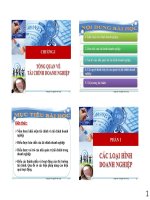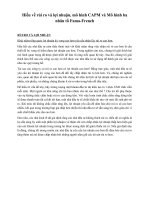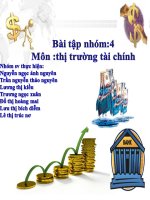Chương 7 Rủi ro và lợi nhuận
Bạn đang xem bản rút gọn của tài liệu. Xem và tải ngay bản đầy đủ của tài liệu tại đây (103.69 KB, 8 trang )
CHAPTER 7
Introduction to Risk, Return, and
The Opportunity Cost of Capital
Answers to Practice Questions
1.
Recall from Chapter 3 that:
(1 + rnominal) = (1 + rreal) × (1 + inflation rate)
Therefore:
rreal = [(1 + rnominal)/(1 + inflation rate)] – 1
a.
The real return on the stock market in each year was:
1999:
2000:
2001:
2002:
2003:
20.4%
-13.8%
-12.4%
-22.8%
29.1%
b.
From the results for Part (a), the average real return was: 0.10%
c.
The risk premium for each year was:
1999:
2000:
2001:
2002:
2003:
18.9%
-16.8%
-14.8%
-22.6%
30.6%
d.
From the results for Part (c), the average risk premium was: –0.94%
e.
The standard deviation (σ) of the risk premium is calculated as follows:
1
× (0.189 − (− 0.0094)) 2 + ( − 0.168 − (−0.0094)) 2 + ( − 0.148 − (−0.0094)) 2
σ 2 =
5
−
1
+ ( −0.226 − (− 0.0094)) 2 + (0.306 − (− 0.0094)) 2 ] = 0.057530
[
σ = 0.057530 = 0.2399 = 23.99%
2.
Internet exercise; answers will vary.
54
3.
a.
A long-term United States government bond is always absolutely safe in
terms of the dollars received. However, the price of the bond fluctuates as
interest rates change and the rate at which coupon payments received
can be invested also changes as interest rates change. And, of course,
the payments are all in nominal dollars, so inflation risk must also be
considered.
b.
It is true that stocks offer higher long-run rates of return than do bonds, but
it is also true that stocks have a higher standard deviation of return. So,
which investment is preferable depends on the amount of risk one is
willing to tolerate. This is a complicated issue and depends on numerous
factors, one of which is the investment time horizon. If the investor has a
short time horizon, then stocks are generally not preferred.
c.
Unfortunately, 10 years is not generally considered a sufficient amount of
time for estimating average rates of return. Thus, using a 10-year average
is likely to be misleading.
4.
In the context of a well-diversified portfolio, the only risk characteristic of a single
security that matters is the security’s contribution to the overall portfolio risk. This
contribution is measured by beta. Lonesome Gulch is the safer investment for a
diversified investor because its beta (+0.10) is lower than the beta of
Amalgamated Copper (+0.66). For a diversified investor, the standard deviations
are irrelevant.
5.
The risk to Hippique shareholders depends on the market risk, or beta, of the
investment in the black stallion. The information given in the problem suggests
that the horse has very high unique risk, but we have no information regarding
the horse’s market risk. So, the best estimate is that this horse has a market risk
about equal to that of other racehorses, and thus this investment is not a
particularly risky one for Hippique shareholders.
6.
xI = 0.60
xJ = 0.40
a.
σI = 0.10
σJ = 0.20
ρIJ = 1
2
2
2
2
2
σ p = [ xI σI + x J σ J + 2(xI x JρIJσIσ J )]
= [ (0.60)2 (0.10)2 + ( 0.40)2 (0.20)2 + 2(0.60)(0. 40)(1)(0.10)(0.20) ] = 0.0196
55
b.
ρIJ = 0.50
2
2
2
2
2
σ p = [ xI σI + x J σ J + 2(xI x JρIJσIσ J )]
= [ (0.60)2 (0.10)2 + ( 0.40)2 (0.20)2 + 2(0.60)(0. 40)(0.50)( 0.10)(0.20 ) ] = 0.0148
c.
ρij = 0
2
2
2
2
2
σ p = [ xI σI + x J σ J + 2(xI x JρIJσIσ J )]
= [ (0.60)2 (0.10)2 + ( 0.40)2 (0.20)2 + 2(0.60)(0. 40)(0)(0.10)(0.20) ] = 0.0100
7.
a.
Refer to Figure 7.11 in the text. With 100 securities, the box is 100
by 100. The variance terms are the diagonal terms, and thus there are
100 variance terms. The rest are the covariance terms. Because the box
has (100 times 100) terms altogether, the number of covariance terms is:
1002 – 100 = 9,900
Half of these terms (i.e., 4,950) are different.
b.
Once again, it is easiest to think of this in terms of Figure 7.11. With 50
stocks, all with the same standard deviation (0.30), the same weight in the
portfolio (0.02), and all pairs having the same correlation coefficient (0.40),
the portfolio variance is:
σ2 = 50(0.02)2(0.30)2 + [(50)2 – 50](0.02)2(0.40)(0.30)2 =0.03708
σ = 0.193 = 19.3%
c.
For a fully diversified portfolio, portfolio variance equals the average
covariance:
σ2 = (0.30)(0.30)(0.40) = 0.036
σ = 0.190 = 19.0%
8.
Internet exercise; answers will vary.
9.
Internet exercise; answers will vary depending on time period.
56
10.
The table below uses the format of Table 7.11 in the text in order to calculate the
portfolio variance. The portfolio variance is the sum of all the entries in the
matrix. Portfolio variance equals: 0.0598355
Alcan
BP
Deutsche
KLM
LVMH
Nestle
Sony
11.
12.
Alcan
0.0018613
0.0005745
0.0012915
0.0018138
0.0015790
0.0002484
0.0010539
BP
0.0005745
0.0011657
0.0004274
0.0007709
0.0004507
0.0002268
0.0003244
Deutsche
0.0012915
0.0004274
0.0029625
0.0015256
0.0015675
0.0001928
0.0014404
KLM
0.0018138
0.0007709
0.0015256
0.0060617
0.0022890
0.0005517
0.0010038
LVMH
0.0015790
0.0004507
0.0015675
0.0022890
0.0036000
0.0000266
0.0020357
Nestle
0.0002484
0.0002268
0.0001928
0.0005517
0.0000266
0.0004903
0.0001503
Sony
0.0010539
0.0003244
0.0014404
0.0010038
0.0020357
0.0001503
0.0046046
Internet exercise; answers will vary depending on time period.
“Safest” means lowest risk; in a portfolio context, this means lowest variance
of return. Half of the portfolio is invested in Deutsche Bank stock, and half of the
portfolio must be invested in one of the other securities listed. Thus, we calculate
the portfolio variance for six different portfolios to see which is the lowest. The
safest attainable portfolio is comprised of Deutsche Bank and Nestle.
Stocks
Deutsche & Alcan
Deutsche & BP
Deutsche & KLM
Deutsche & LVMH
Deutsche & Nestle
Deutsche & Sony
13.
Portfolio Variance
0.090733
0.061042
0.147923
0.118795
0.047021
0.127987
Internet exercise; answers will vary depending on time period.
14. a. In general, we expect a stock’s price to change by an amount equal to (beta ×
change in the market). Beta equal to –0.30 implies that, if the DAX
suddenly increases by 5 percent, then the expected change in the stock’s
price is –1.5 percent. If the DAX falls by 5 percent, then the expected
change is +1.5 percent.
b.
“Safest” implies lowest risk. Assuming the well-diversified portfolio is
invested in typical securities, the portfolio beta is approximately one. The
largest reduction in beta is achieved by investing the €30,000 in a stock
with a negative beta. Therefore, invest in the stock with β = –0.30.
57
c.
r = rf + β(rm – rf)
For the stock with β = 0.30:
0.064 = 0.04 + 0.30(rm – rf) ⇒ (rm – rf) = 0.08
For the stock with β = –0.30:
r = 0.04 + –0.30(0.08) = 0.016 = 1.6%
15. Internet exercise; answers will vary depending on time period.
58
Challenge Questions
1.
a.
In general:
Portfolio variance = σP2 = x12σ12 + x22σ22 + 2x1x2ρ12σ1σ2
Thus:
σP2 = (0.52)(0.5302)+(0.52)(0.4752)+2(0.5)(0.5)(0.72)(0.530)(0.475)
σP2 = 0.21726
Standard deviation = σP = 0.466 = 46.6%
b.
We can think of this in terms of Figure 7.11 in the text, with three
securities. One of these securities, T-bills, has zero risk and, hence, zero
standard deviation. Thus:
σP2 = (1/3)2(0.5302)+(1/3)2(0.4752)+2(1/3)(1/3)(0.72)(0.530)(0.475)
σP2 = 0.09656
Standard deviation = σP = 0.311 = 31.1%
Another way to think of this portfolio is that it is comprised of one-third
T-Bills and two-thirds a portfolio which is half Dell and half Microsoft.
Because the risk of T-bills is zero, the portfolio standard deviation is twothirds of the standard deviation computed in Part (a) above:
Standard deviation = (2/3)(0.466) = 0.311 = 31.1%
c.
With 50 percent margin, the investor invests twice as much money in the
portfolio as he had to begin with. Thus, the risk is twice that found in Part
(a) when the investor is investing only his own money:
Standard deviation = 2 × 46.6% = 93.2%
d.
With 100 stocks, the portfolio is well diversified, and hence the portfolio
standard deviation depends almost entirely on the average covariance of
the securities in the portfolio (measured by beta) and on the standard
deviation of the market portfolio. Thus, for a portfolio made up of 100
stocks, each with beta = 1.77, the portfolio standard deviation is
approximately: (1.77 × 15%) = 26.55%. For stocks like Microsoft, it is:
(1.70 × 15%) = 25.50%.
59
For a two-security portfolio, the formula for portfolio risk is:
Portfolio variance = x12σ12 + x22σ22 + 2x1x2ρρ12σ1σ2
If security one is Treasury bills and security two is the market portfolio, then σ1 is
zero, σ2 is 20 percent. Therefore:
Portfolio variance = x22σ22 = x22(0.20)2
Standard deviation = 0.20x2
Portfolio expected return = x1(0.06) + x2(0.06 + 0.85)
Portfolio expected return = 0.06x1 + 0.145x2
Portfolio
X1
X2
1
2
3
4
5
6
1.0
0.8
0.6
0.4
0.2
0.0
0.0
0.2
0.4
0.6
0.8
1.0
Expected
Return
0.060
0.077
0.094
0.111
0.128
0.145
Standard
Deviation
0.000
0.040
0.080
0.120
0.160
0.200
0.2
Expected Return
2.
0.15
0.1
0.05
0
Standard Deviation
60
3.
Internet exercise; answers will vary.
4.
The matrix below displays the variance for each of the seven stocks along the
diagonal and each of the covariances in the off-diagonal cells:
Alcan
BP
Deutsche
KLM
LVMH
Nestle
Sony
Alcan
0.0912040
0.0281494
0.0632841
0.0888786
0.0773724
0.0121706
0.0516420
BP
0.0281494
0.0571210
0.0209436
0.0377740
0.0220836
0.0111135
0.0158935
Deutsche
0.0632841
0.0209436
0.1451610
0.0747522
0.0768096
0.0094488
0.0705803
KLM
0.0888786
0.0377740
0.0747522
0.2970250
0.1121610
0.0270320
0.0491863
LVMH
0.0773724
0.0220836
0.0768096
0.1121610
0.1764000
0.0013020
0.0997500
Nestle
0.0121706
0.0111135
0.0094488
0.0270320
0.0013020
0.0240250
0.0073625
Sony
0.0516420
0.0158935
0.0705803
0.0491863
0.0997500
0.0073625
0.2256250
The covariance of Alcan with the market portfolio (σAlcan, Market) is the mean of the
seven respective covariances between Alcan and each of the seven stocks in the
portfolio. (The covariance of Alcan with itself is the variance of Alcan.)
Therefore, σAlcan, Market is equal to the average of the seven covariances in the first
row or, equivalently, the average of the seven covariances in the first column.
Beta for Alcan is equal to the covariance divided by the market variance (see
Practice Question 10). The covariances and betas are displayed in the table
below:
Alcan
BP
Deutsche
KLM
LVMH
Nestle
Sony
Covariance
0.0589573
0.0275826
0.0658542
0.0981156
0.0808398
0.0132078
0.0742914
Beta
0.9853
0.4610
1.1006
1.6398
1.3510
0.2207
1.2416
61
![chương 13 Rui ro va loi nhuan [Compatibility Mode]](https://media.store123doc.com/images/document/13/y/xh/medium_RpdpAoiSgh.jpg)








